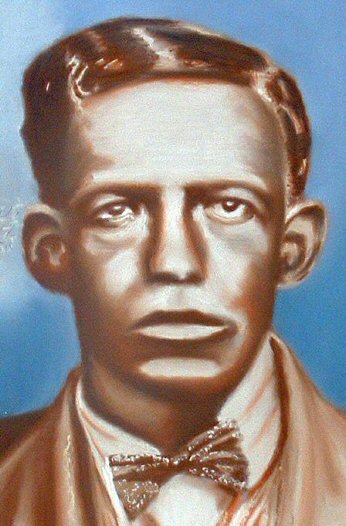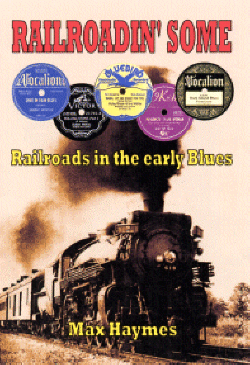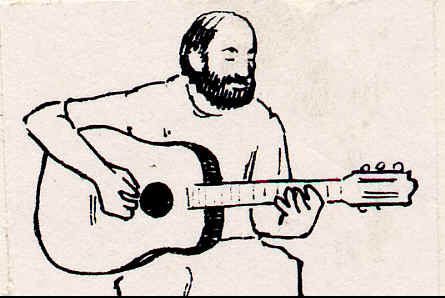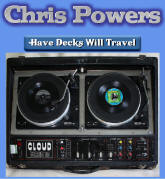|
“RAILROADIN’
SOME” by Max Haymes
This
groundbreaking book, written by one of the foremost blues
historians in the UK, is based on over 30 years
research, study and absolute passion for early blues music. It is the
first ever comprehensive study of the enormous impact of the railroads on 19th
and early 20th Century black American society and the many and varied references
to this new phenomenon in early blues lyrics.
Below
is a synopsis of the book giving you an insight into the wealth of detail. If
you're interested in getting a copy, then please check out
Music Mentor Books by clicking the link above.
Chapter
1:
“SMOKESTACK IS BLACK AN’
THE BELL IT SHINE LIKE GOLD”
Brief background of
railroads in the antebellum era and slaves’ involvement — role of Pullman and
Red Cap porters — the Panama Limited — origins of ‘smokestack lightning’
and Charley Patton — ‘ticket as long as my right arm’, ‘ballin’ the jack’
— the ‘other’ Midnight Special — Texas & New Orleans RR and Lucille Bogan.
Chapter
2:
“SKIPPIN’ 'ROUND FROM LOG TO
LOG”
Evolution of logging
camps in the South — origins of piano blues, boogie woogie and the barrelhouse —
oral transmission of early blues via logging roads — more on the T&NO.
Chapter
3:
“AH! WHEN I LEAVE FROM HERE, GONNA CATCH THAT M. & O.”
The story of the Mobile &
Ohio and the blues from 1852 to 1940; a ’journey’ from Mobile to St. Louis —
background of the floating bridge of Sleepy John Estes fame — Cairo, Ill. — the
real facts of Casey Jones’ train wreck in 1900 — river bottoms — the Union
Stockyard in Meridian, Miss. — oral transmission and (a) way freight trains on
the M&O, (b) stevedores at Mobile Bay.
Chapter
4:
“SHE’S GIVIN’ IT AWAY”
Short history of the
refrigerator car or ‘reefer’ from 1858 to 1910 — introduction of the banana to
the ‘masses’ in the black community — fast freights: the ‘redball’ and the
‘hotshot’ — hoboing on a reefer with T-Bone Walker and David ‘Honeyboy’ Edwards
— sexual symbolism and street market blues — English music hall link with some
early vaudeville-blues singers.
Chapter
5:
“GOIN’ WHERE THE
SOUTHERN CROSS THE YELLOW DOG”
Origins of the ‘Yellow
Dog’ — short history of the Yazoo & Mississippi Valley RR — peavine railroads —
brief survey of labour history and anti-union railroad companies — yellow dog
contracts —recordings of the Yellow Dog from 1923 to 1961, by Sam Collins,
Bessie Smith et al.
Chapter
6:
“AN’ THAT THING DON’T
KEEP A-RINGIN’ SO SOON”
Brief study of
early Southern prison/correction systems — convict lease and railroads’
involvement — source of the ‘longest train’ motif in the blues — origin of ‘In
The Pines’ — Joseph E. Brown and Peg Leg Howell — brief survey of the Tennessee
Coal, Iron & Railroad Co. or ‘TCI’, and singers — Railroad Bill and the L&N —
short history of Gulfport & Ship Island RR and Robert Johnson link — the ‘ding
dong’ and Frank Stokes.
Chapter
7:
“RUNNIN’ DOWN TO THE
STATION”
Resumé of beginnings of
the Fast Mail in 1875 — importance to rural South — source of John Byrd’s
‘Billy Goat Blues’ in the 1850s — fast mail trains such as the Big 80 and
the Sunnyland — lineage of Robert Johnson’s ‘fastest train I see’
verse — streamline trains — blues singers’ knowledge of railroad operations —
the railroad depot: the seamier side and the ‘leaving scene’ in the blues, as
related by Robert Wilkins, Roosevelt Sykes, Ma Rainey and Robert Johnson.
Chapter
8:
“I CARRIED WATER FOR THE ELEPHANT”
Short history of
development of circus and carnival in the South — beginnings of medicine shows —
circuses in Natchez, Miss. during antebellum era and the early minstrel song,
‘Billy Barlow’ — excursion trains — blues singers’ role in circus and origin of
‘ballyhoo’ — circus and carnival slang used in the blues — role of steam
calliope — short survey of origin of ‘hokum’ and hokum blues — the railroad
crossing — vaudeville-blues singers and travelling shows including Clara Smith —
oral transmission process.
Chapter
9:
“GONNA LEAVE A PULLMAN
AN’ RIDE THE L. & N.”
Vaudeville blues lyrics
and influence on rural singers like Blind Lemon Jefferson by Sippie Wallace, Ida
Cox and others — oral transmission and the blues record — passenger train women,
platform vendors and Blind Boy Fuller — survey and ancestry of ‘Careless Love’ —
Mae Glover, John Byrd, Bobby Grant and Buddy Boy Hawkins — roots of ‘Statesboro
Blues’ by Blind Willie McTell.
Chapter
10:
“LINED OUT SMOKIN', LOOK LIKE
IT TAKIN' TO SCAT”
Short survey of early
tramps and hobos on the rails — women hobos and Memphis Minnie — Chicago, the
railroad hobo’s ‘Mecca’ — hobo jungles and ‘Hoovervilles’ — symbolism of the
railroad and ultimate freedom for the hobo — The Atlanta Special, Bukka
White and Blind Willie McTell — riding the blinds and riding the rods — railroad
police and Sleepy John Estes — origins of ‘hobo’.
Epilogue
Appendix I - Origins of
'red light district'
Appendix II - 'In The
Pines'/'The Longest Train' and the "accident stanzas"
Glossary of Railroad Abbreviations and Nicknames
Index of Artists' Names
Index of Song Titles
General Index
Additionally, there is a fully annotated Discography
at the end of each chapter.
Click here to read some reviews of 'Railroadin'
Some'
To order the
book click here
__________________________________________________________________________
Top of Page
Website © Copyright 2000-2011 Alan White. All Rights Reserved.
Text (this page) ©
Copyright 2006 Max Haymes. All rights reserved.
For further information please email:
alan.white@earlyblues.com

|










